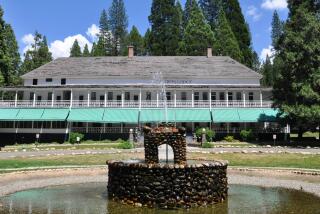$120 Million Spent on Once-Derelict Willard : Capital’s Historic ‘Hotel of Presidents’ Will Reopen
- Share via
WASHINGTON — The Willard Hotel, where Abraham Lincoln once hung his stovepipe hat, is nearing the end of a $120-million refurbishing after standing for almost two decades as a ghostly derelict on Pennsylvania Avenue.
If the restoration project, which was started in late 1983, remains on schedule, an elegant new “Hotel of the Presidents” will reopen in September, another step in the renaissance of the grand boulevard.
Adjacent Office Building
An adjacent 12-story office building, imitating the Willard’s ornate beaux-arts architectural style and including a new version of the landmark Occidental Restaurant, is expected to begin receiving tenants in May.
“This will be a 21st-Century hotel with many of the amenities of the past,” developer Oliver T. Carr said.
There has been a hotel at the northwestern corner of 14th Street and Pennsylvania Avenue, two blocks east of the White House, since the early 1800s, but it did not become the Willard until 1850.
The present building was completed in 1901 by architect Henry Hardenbergh, who designed New York City’s Plaza Hotel and Waldorf-Astoria also.
In its glory days, the Willard was a temporary residence for opera superstar Jenny Lind, circus dwarf Tom Thumb and the first Japanese Embassy. Lincoln checked into the Willard under heavy guard one dark night before his inauguration in 1861 and borrowed a pair of bedroom slippers from host Henry Willard.
Mark Twain Slept There
Mark Twain swaggered down Peacock Alley, the block-long hotel corridor once called “the principal artery of Washington’s social life,” and wrote a couple of best sellers upstairs. Julia Ward Howe wrote the words to “The Battle Hymn of the Republic” in her room.
In the Round Robin Bar, Henry Clay of Kentucky was said to have mixed the first mint julep ever tasted in Washington, and Henry M. Stanley stood at the bar recounting how he had found missionary David Livingstone in Africa.
In a room at the Willard, Lincoln received word from a North-South peace commission that attempts to avert a civil war had failed. In 1867, the Willard opened Washington’s first soda fountain, offering “refreshing summer draughts.” President Calvin Coolidge moved into the Willard in 1923 to wait for Warren G. Harding’s widow to leave the White House.
Closed After Rioting
The Willard fell into disrepair in the 1960s and was closed in mid-1968 after racial rioting that followed the assassination of Martin Luther King Jr. Its demolition, threatened by a federal plan to build a vast National Square in the neighborhood, was averted several times--once with the intervention of Sen. Daniel Patrick Moynihan (D-N.Y.).
An auction and souvenir hunters had stripped the main lobby bare. Vagrants were spending the night behind the hotel’s boarded-up doors, pigeons were roosting in its broken windows and weeds were growing on the curved mansard dormers outside the Willard’s once-glittering rooftop ballroom.
Finally, in 1977, after Congress created the Pennsylvania Avenue Development Corp., a court ordered the government to pay the Willard’s owner $8 million and to take possession of the historic landmark.
Carr was awarded the renovation contract, and a 99-year lease to run the Willard was granted to Intercontinental Hotels Corp., a chain owned by a British conglomerate.
Sumptuous Interiors
With John Barianos, a Greek craftsman, overseeing the restoration of woodwork, plaster, marble and decorative paintings to match the sumptuous interiors of the old Willard as closely as possible, the Crystal Room, the Willard Room, the Round Robin Bar and Peacock Alley are coming alive again.
A menu of American regional delicacies will be introduced in the Willard Room, where Lincoln lunched on roast beef, boiled potatoes and gravy, boiled cabbage, black-eyed peas, salad, bread and blueberry pie immediately after his inauguration in 1861.






